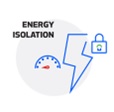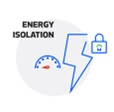Title Page
-
Site conducted
-
Conducted on
-
Prepared by
-
Location
Untitled Page
-
Signature:
-
Date:
-
Please read all questions fully before answering. For multiple-choice questions, there is only one answer; choose the best response. A grade of >80% is required to pass successfully. Each question is worth 3 points
-
What are the critical behaviors in shock prevention?
- Power off the equipment and lockout/tagout per procedure
- Wear rubber-insulatinggloves
- Use insulated Tools
- All the above
-
Power off the equipment and lockout/tagout per procedure
-
Wear rubber-insulating gloves
-
Use insulated tools
-
All the above
-
You may perform energized repair work on electrical equipment above 50 V without any approval
-
True
-
False
-
If you are not performing any work, you may enter an arc flash boundary without wearing PPE
-
True
-
False
-
The arc flash boundary is always 42 inches
-
True
-
False
-
Area in front of an electrical panel can be used as storage space as long as there is at least 24 inches of Clear Space
-
True
-
False
-
Arc flash hazard labels placed on equipment after an Arc Flash Analysis has been completed will tell you what information (choose 3):
-
Tools to use
-
Arc flash boundary
-
Voltage
-
Required PPE level or incident energy (cal/cm2) at a specific distance
-
Work procedures
-
Crew supervisor
-
Energized state
-
When working within the restricted approach boundary, you must have and use the following:
-
Voltage rated gloves
-
Rated insulated tools
-
Leather protective shoes
-
All the above
-
If working inside a low voltage restricted approach boundary, there is an increased likelihood of electrical shock
-
True
-
False
-
When should you barricade or guard a low voltage work zone if exposed, energized parts are present?
-
Always
-
When an arc flash hazard is present
-
When other people are working on electrical equipment
-
An Unqualified Person, wearing PPE, may enter the Limited Approach Boundary unescorted
-
True
-
False
-
When should voltage test instrument be verified to be working properly?
-
Before testing
-
After testing
-
Both, before and after testing
-
First thing each day
-
Portable GFCIs should be tested before each use
-
True
-
False
-
Where must your LOTO key be kept when your lock is applied:
-
On yourself
-
Shock protection PPE that includes voltage-rated gloves is not required unless the nominal voltage is greater than 120 volts
-
True
-
False
-
The flow of electric current flowing through a conductor is measured in
-
Amps
-
Ohms
-
Volts
-
side
-
The side of the power source that is connected to the ground is often called the
-
Neutral
-
Grounded
-
Hot
-
Which of the following objects are good conductors of electricity?
-
Human body
-
Copper
-
Steel
-
All the above
-
is detected, a GFCI will quickly trip, interrupting the circuit and stopping the flow of current
-
When a difference of
-
5 milliamps
-
10 milliamps
-
15 milliamps
-
30 milliamps
-
If you are troubleshooting in an energized panel, there must be a barrier set up prior to beginning work
-
True
-
False
-
Which of the following PPE is required when the equipment label states an incident energy of 7 cal/cm2? (Check all that apply)
-
Long sleeve shirt & pants; or coveralls rated at HRC2
-
Arc rated face shield
-
Arc rated balaclava
-
Hard hat (class G)
-
Safety glasses or goggles
-
Hearing protection
-
Leather footwear
-
Voltage rated rubber gloves
-
Leather protector gloves
-
Undergarments, non-melting material (cotton, wool, or silk)
-
Prior to using electrically insulating gloves, what test must be performed by the user on the gloves?
-
Di-electric test
-
Air leak test
-
No test is required
-
Leather protector gloves must be worn over the rubber insulating gloves
-
True
-
False
-
If I do not have rated insulated tools, it is acceptable to use non-voltage rated tools since that is all I have
-
True
-
False
-
An arc flash is an electrical breakdown of a gas which produces an ongoing plasma discharge, resulting from a current flowing through normally nonconductive media such as air. In an arc flash event, plasma temperature can reach 10,000OF and fatal burns can occur at distances over 10 feet
-
True
-
False
-
Which of the following is the most effective for arc flash prevention using the hierarchy of controls concept of eliminating the hazard?
-
Create an electrically safe working condition
-
Arc-resistant equipment
-
Arc flash boundary
-
Arc rated protective equipment such as shields or blankets
-
Arc rated PPE
-
What should you do if you see someone getting electrically shocked?
-
Do not touch the person, as you will only become a second victim
-
Turn off energy source, if possible
-
Dislodge the person from the energy source by using a non-conductive item
-
All the above
-
Creating a boundary is required when performing work activities while energized and exposed conductors are present. Which of the following is an acceptable practice for creating boundaries?
-
Tape – must be red, contain the words “Danger”. Other language can be on the tape such as “Keep Out”, “Do Not Enter”, “Electrical Hazard”, etc
-
Cones – must be red and used in conjunction with a sign that provides the same wording as the tape above
-
Either A or B
-
Before starting each job involving exposure to electrical hazards, a qualified employee must complete an (EEWP) Energized Electrical Work Permit and a job safety plan and conduct a job briefing with the employees involved
-
True
-
False
-
Only Qualified Employees are permitted to manually energize a circuit that has been de-energized by the automatic operation of a circuit protective device
-
True
-
False
-
If the equipment you are about to work on does not have an Arc Flash Label, what is the best action you can take?
-
Take a wild guess
-
Ask the person working with you
-
Stop work, contact your Supervisor and Safety
-
None of the above
-
When working on or exposed to electrically energized equipment or circuit parts, the only acceptable means of LO/TO verification is “Absence of Voltage Measurement” using approved voltage test equipment such as a Fluke Multimeter
-
True
-
False
-
GFCI protection is required when using extension cords or flexible cord/plug connected equipment in which of the following circumstances?
-
For all construction and maintenance activities
-
For any conductive work locations (water or other conductive liquids)
-
For all outdoor activities supplied by 125V (up to 30 amp)
-
For all outdoor activities supplied by > 125V, GFCI protection or an assured equipment grounding conductor program is required
-
All the above
-
If a coworker has an electrical incident, you should immediately disconnect the power source and call emergency medical services
-
True
-
False











